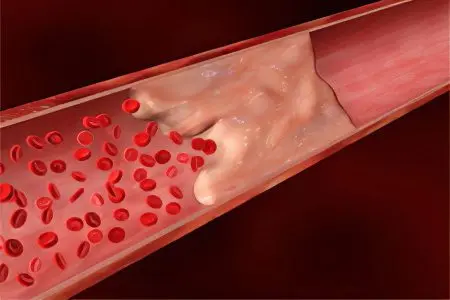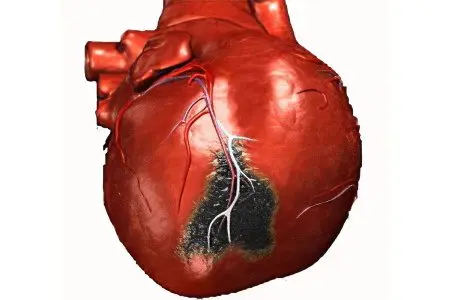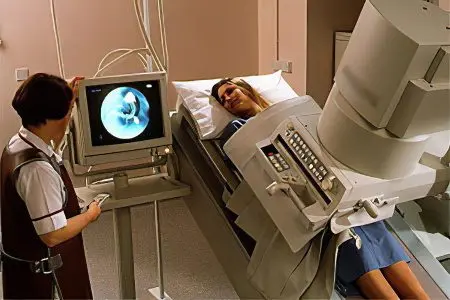Contents

Thrombosis of the mesenteric artery is a violation of blood circulation in the mesenteric vessels. This condition in 25% of cases is the cause of acute intestinal ischemia. Pathology is expressed in severe pain in the lower abdomen, which is accompanied by diarrhea, vomiting with bloody impurities, and shock. To help the patient, he needs to urgently perform an operation.
The superior mesenteric artery supplies blood to the small intestine, caecum, ascending colon, and transverse colon. Part of the transverse colon, the entire colon, the sigmoid colon, and the rectum are supplied by the inferior mesenteric artery. Most often, the superior mesenteric artery, which is responsible for the blood supply to the digestive tract as a whole, suffers. However, a mixed lesion of the mesenteric veins and arteries cannot be ruled out. First, a thrombus clogs the lumen of one vessel, and then a chronic obstruction of another vessel develops. The disease most often affects men over the age of 50 years.
Until now, thrombosis of the mesenteric artery remains an urgent problem for surgeons. This is explained not only by the difficulties in diagnosing a pathological condition, but also by the fact that it can be provoked by many reasons and often leads to the death of the patient.
Causes of thrombosis of the mesenteric artery

Thrombosis of the mesenteric artery can be due to several reasons, including:
Diseases of the heart and blood vessels: atherosclerosis, heart disease, rheumatism, vasculitis, hypertension, arrhythmia, abdominal aortic aneurysm.
Postponed operations on the cardiac aorta.
The presence in the body of a tumor of a malignant nature.
Blood hypercoagulability, polycythemia vera, thrombocytosis, sickle cell anemia.
Childbearing period.
Taking hormonal drugs for the purpose of contraception.
Paraneoplastic syndrome.
Infection of organs located in the peritoneal cavity, including diverticulitis, appendicitis, etc.
Cirrhosis of the liver with portal hypertension leading to venous congestion.
Surgical intervention, accompanied by trauma to the mesenteric artery.
Anastomosis.
Acute inflammation of the pancreas.
decompensated disease.
Thrombosis occurs when the mesenteric artery is blocked by thrombotic masses. As a result, blood flow slows down, which leads to pathological changes in the organ.
There are three options for the development of this pathological condition:
In the first case, the blood flow can be restored spontaneously, or with the help of drugs (thrombosis with compensation of the blood flow of the mesenteric artery). In this case, the functioning of the intestine will not be disturbed.
In the second case, a violation of blood flow will lead to various diseases of the intestine (thrombosis with subcompensation of the blood flow of the mesenteric artery).
In the third case, a violation of blood flow causes purulent peritonitis, sepsis and death of the patient (decompensated thrombosis).
Risk groups
There are categories of patients who are at risk for the development of thrombosis of the mesenteric artery:
Elderly people.
Patients with malignant tumors of the peritoneum.
Patients who have had myocardial infarction.
Patients who underwent atrial fibrillation.
Patients with atherosclerosis.
Symptoms of mesenteric artery thrombosis
Acute thrombosis of the mesenteric artery has a sudden onset. Severe pain comes to the fore. They are localized in the abdomen, proceed according to the type of contractions. A person is unable to stay still, he constantly rushes about in search of a comfortable body position that allows him to relieve pain. The patient feels best when the knees are tightly pressed to the stomach.
Other signs of thrombosis of the mesenteric artery:
The patient is nauseated and may vomit. Bile and blood are found in the vomit. Then the smell of feces will begin to come from vomiting.
The stool is liquid, blood is visible in it.
The skin of the face and body becomes cyanotic.
Shock may develop.
Blood pressure rises, bradycardia is observed.
After 6-12 hours from the onset of the development of the pathological process, the pain becomes less intense. At the same time, it acquires a clearer localization, that is, it does not spill over the entire peritoneum, but is concentrated in the intestinal area.
In the area between the navel and the pubis, a tumor-like seal can be felt.
The patient’s health is getting worse: the pulse quickens, but the blood pressure returns to normal.
After 18-36 hours from the start of the first symptoms, the patient develops peritonitis. His condition deteriorates sharply, the pain becomes incredibly intense, especially during physical activity. Growing signs of intoxication of the body.
The patient cannot empty the intestines, as its paralytic obstruction develops.
Body temperature rises sharply.
So, in its development, mesenteric artery thrombosis goes through three phases: hyperactive phase (first 6-12 hours), paralytic phase (12-18 hours) and shock (18-36 hours).
Diagnosis of thrombosis of the mesenteric artery

During the examination of a patient who came to a medical facility in the first hours from the onset of thrombosis, the doctor will find a soft stomach, participation of the peritoneal wall in breathing. There are no symptoms of internal irritation of the peritoneum, that is, the severity of the pathology does not correspond to the initial symptoms of the disease. This is one of the factors complicating the correct diagnosis. An increase in body temperature and signs of irritation of the peritoneum will occur only at the stage of peritonitis, when it will be difficult for the patient to help.
It is imperative to clarify with the patient whether he previously had an attack of angina pectoris with abdominal pain, which would occur after eating. As a rule, about 50% of patients with mesenteric artery thrombosis give a positive answer to this question. Since the process of digestion of food increases intestinal perfusion, the patient may suffer from malnutrition, as such patients often develop fear of eating, and saturation occurs much faster.
Suggestive of thrombosis of the mesenteric artery can be such conditions in the history of the disease as: ischemic heart disease, atherosclerosis, obliterating endarteritis, as well as surgical interventions on the aorta.
What you should pay attention to:
Against the background of the development of intestinal necrosis, the pain may subside somewhat. Patients take this as a trend towards improvement, which is a false opinion.
Narcotic painkillers do not reduce the intensity of pain. At the beginning of the development of symptoms of thrombosis, antispasmodics are much more effective.
As the disease progresses, intoxication of the body increases.
Symptoms of thrombosis most often do not correspond to the severity of ischemic bowel disease.
To perform a qualitative diagnosis, it is necessary to perform the following studies:
X-ray of the intestine. Such indicators as: excessive stretching of the intestine, its compacted wall, etc., should pay attention to themselves. The specificity of the method does not exceed 30%.
CT scan of the intestine. Signs of thrombosis of the mesenteric artery: swelling of the intestinal wall, hemorrhages in certain parts of the intestine. This method allows visualization of the thrombus. However, CT with vascular angiography has greater specificity. This study allows to detect thrombosis in 94% of cases.
Angiography of intestinal vessels. Allows you to make a correct diagnosis in 88% of cases.
Ultrasound has specificity in 92-100% of cases. However, if the thrombus is located outside the main vessels, then the study will not allow it to be detected. Therefore, this method is not taken as a basis, regarding it as an auxiliary one.
Other methods to clarify the diagnosis: MRI (disadvantages: expensive research, lack of necessary equipment in many clinics, but the high specificity of the method), echocardiography (makes it possible to clarify the source of a blood clot), ECG, etc.
Blood must be taken from the patient for biochemical and general analysis, as well as for a coagulogram.
Treatment of thrombosis of the mesenteric artery

After admission to the hospital, the patient is placed in the intensive care unit.
He is shown the following treatment:
Restoration of the water-salt balance of the body.
Correction of the level of electrolytes.
Oxygen therapy.
If there are indications, then the patient is given a blood transfusion.
Pressure and diuresis control.
Placement of a nasogastric tube.
Normalization of the work of the heart muscle.
Relief of pain.
Prescribing broad-spectrum antibacterial drugs.
Blood-thinning drugs that dissolve blood clots are administered intravenously.
Operative therapy
Surgical intervention:
Intestinal resection is prescribed provided that the patient develops peritonitis.
Revascularization with further anastomosis can also be considered as a method of surgical treatment for mesenteric artery thrombosis.
According to different authors, the death of patients with mesenteric thrombosis can reach 50-100%. A more accurate prognosis depends on the speed of seeking medical help. It is aggravated by the fact that many patients go to the doctor already with developed intestinal necrosis, or with peritonitis. If the patient refuses the operation, then death occurs in 100% of cases.
Prevention
Prevention of thrombosis of the mesenteric artery comes down to maintaining a healthy lifestyle, quitting smoking. It is also important to monitor body weight, avoiding obesity.
It is imperative to treat all diseases that pose a threat to the formation of a blood clot. We are talking about atherosclerosis, rheumatism, arrhythmias, etc.
[Video] Cardiovascular surgeon, phlebologist Abasov M. M. – Products that thin blood clots:









